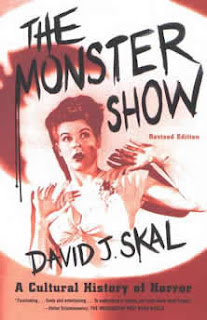 One of the books I have been reading in my spare time is one that I received as a Christmas gift, David J. Skal, The Monster Show: A Cultural History of Horror, rev. ed (New York: Faber and Faber, 2001). This book does a nice job of bringing together various elements of approach to the horror as an object of not only fan appreciation, but also analysis from historical, cultural, and social perspectives.
One of the books I have been reading in my spare time is one that I received as a Christmas gift, David J. Skal, The Monster Show: A Cultural History of Horror, rev. ed (New York: Faber and Faber, 2001). This book does a nice job of bringing together various elements of approach to the horror as an object of not only fan appreciation, but also analysis from historical, cultural, and social perspectives.
As I was reading last night a chapter on horror in the 1960s was of special interest to me as this was the decade in which I was born, and thus it was formative in my encounter with horror in the very early 1970s. At one point Skal references “Monster Culture, a phenomenon of horror-movie hoopla that began in the late fifties and continued into the mid-sixties.” An interesting aspect of Skal’s discussion of Monster Culture is his reference to various “participatory rituals” for fans within this culture that take on an almost religious or spiritual aura. At one point Skal discusses one element of horror fan culture in the 1960s, the Aurora Plastics model kits of the Universal Pictures classic monsters, and he notes that as Stephen King referenced this in his novel Salem’s Lot, that it is done with “religio-mythic overtones.” Skal goes on to note that “[m]onsters have traditionally been part of adolescent initiation rituals,” and he then quotes a 1975 essay by Walter Evans that connects such rituals with religion and spirituality. The essay is titled “Monster Movies and Rites of Initiation,” and as quoted by Skal, Evans wrote:
“Most of the definitive elments of premodern societies’ initiation rites also function as definitive elements in the monster movie formula. Fascination with the distant past; the prominence of superstition or archaic religion; the focus on myth; beings who perform an initiatory function; the complementary focus on innocent and untested young people who are transformed by contact with these beings; the symbolic deaths and rebirths; the use of thunder, darkness, and other motifs in elaborate scenarios designed to create terror; the emphasis on ritual passing on of archaic lore by learned elders; these are only some of the most important of numerous formulaic elements which point to the monster movies’ crucial function in the vital process of initiation which modern American adolescents require and demand no less than their brothers and sisters of premodern societies.”
Beyond the general ritual and religious function of horror in society among adolescents, and particularly among those who inhabit Monster Culture, Skal makes a comment that connects horror and religion even more strongly:
“Monsters – as this writer will personally attest – provided an element of reassurance. They were transcendent resurrection figures, beings who couldn’t die. The traditional monsters were perversely Christlike. (Dracula’s most characteristic pose, with outstretched cape, is a blatant cruciform), offering an image of survival, however distorted or grotesque.”
I find Skal’s recognition of the ritual and religious function of horror in culture to be of great interest, and I hope to pursue these research areas in more depth with my continued reading. One book in my “to be read” stack that I have mentioned before on this blog is Roger C. Aden, Popular Stories and Promised Lands: Fan Cultures and Symbolic Pilgrimages (Tuscaloosa and London: The University of Alabama Press, 1999). My studies in anthropology got me interested in pilgrimage, and the idea that this has relevance to popular culture is intriguing. I first saw this book referenced in connection with anime in Mechademia, an academic journal on the topic and I recognized that it has promising application elsewhere. It appears to address Victor Turner’s thesis on liminality, ritual, and communitas, and then connects this to pilgrimage (symbolic and literal) as it relates to various aspects of pop culture fandom. As the dust cover for the book states,
“this book makes a compelling case for understanding the alleged vast wasteland of popular culture as a fertile site of individually and communally created ‘sacred places.’ Through popular stories, fans can imaginatively experience symbolic pilgrimages to new promised lands that offer a sense of centeredness, spirituality, and creativity.”
It seems that Skal’s observations on the impact and significance of horror to American culture and the social order have merit and are worthy of further reflection.





This discussion reminds me a bit of the opening scene of Larry Fessenden’s film Wendigo in which the young boy is playing with two figures: a space-man, and a werewolf…the rational, modern archetype versus the wild, animal archetype…
another book I must get for my research! (and enjoyment, no doubt)